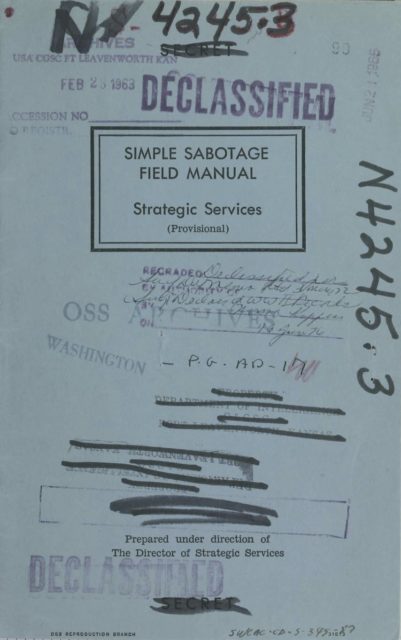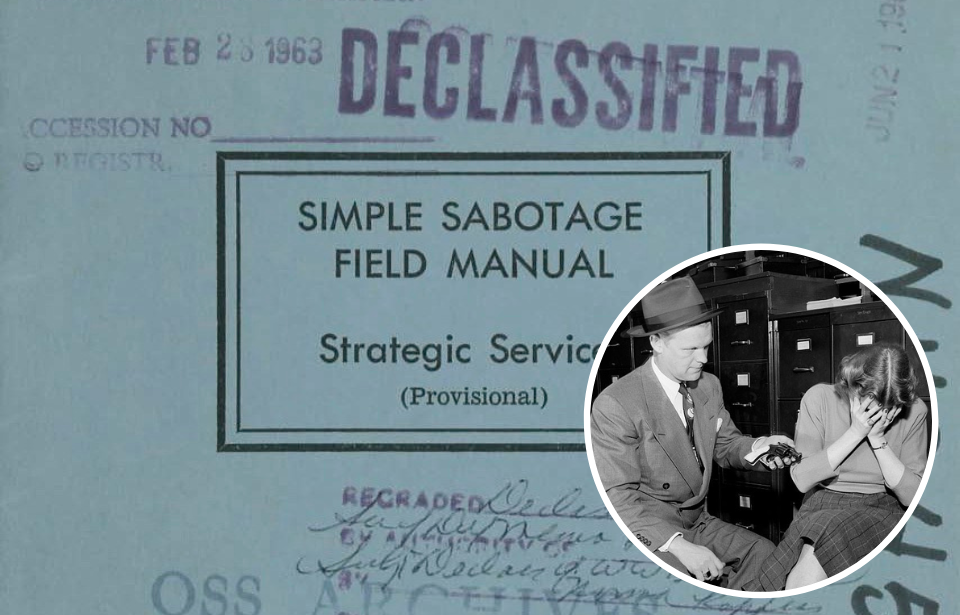As the Second World War raged on, the Allied and Axis powers employed various tactics to gain ground. One way was to utilize spies and saboteurs to undermine their enemies. The United States decided to expand this past professional spies, allowing anyone in enemy territory to partake in sabotage.
The country’s intelligence agency created a manual that was distributed throughout enemy countries to recruit people to help with sabotage efforts. The unexpected heroes? Bad employees who were tasked with undermining productivity in the workplace – all in the name of helping the Allies win the war!
The Office of Strategic Services
The Office of Strategic Services (OSS) was the precursor to the CIA and formed as an agency of the Joint Chiefs of Staff (JCS). Created during the Second World War, it started off as a much smaller operation known as the office of the Coordinator of Information (COI), under the command of Maj. Gen. William J. “Wild Bill” Donovan. After the Japanese attack on Pearl Harbor, it expanded and began doing more for the war effort.

The organization was broken down into different departments, which dealt with everything from obtaining secret intelligence to recruiting enemy agents and counter-espionage. Strategic Services Operations was one of the main departments within the OSS and had branches responsible for training resistance fighters, as well as instigating sabotage and causing mayhem in enemy countries. It was also responsible for the creation the Simple Sabotage Field Manual.
Sabotage is for everyone
The Simple Sabotage Field Manual was created with everyone in mind. It was intended to be a simple guide for those living in Axis countries, and detailed how these disenchanted citizens could undermine production and transportation to help the Allied cause. Certain parts were also used for leaflets or presented over the radio. Occasionally, the manual was also explained in person.

There are two different types of sabotage promoted within the manual: physical acts and purposeful human errors. It gave examples of how one could be physically disruptive, including how to slow down factory production by ruining materials. There were even tips on how to use every day objects, such as hairpins, to break things.
Hysterically crying to win the war
The examples the OSS provided for ways human error could disrupt daily life are far more creative. They were rooted in potential saboteurs making poor decisions and adopting a non-cooperative attitude while getting others to do the same.

The OSS urged citizens to “cry and sob hysterically at every occasion,” particularly if they were talking to a government official, or to bring a bag of moths to release during the showing of a propaganda film, so they would fly to the projector and block the show. To impact transportation, the manual suggested that train conductors issue two tickets for the same seat. to purposefully cause an argument.
Espionage tactics for middle management
While the manual included sabotage ideas that anyone could engage in, it included a number of ideas specifically for those who held middle management positions in the workplace. These professionals were given specific instructions to bring up irrelevant issues as often as they could, debate specific wording, hold unnecessary conferences and promote bad workers. They were also encouraged to speak as frequently as possible and to turn regular conversations into “speeches.”
The manual also suggested management cause problems with their products by approving defective work, assigning out unimportant work first, giving incomplete or misleading instructions to new employees, favoring bad or lazy workers to lower morale, and delaying stock orders, so there was a higher chance of a shut down due to delayed order fulfilment.

More from us: Julia Child Was An OSS Agent Before She Was A World Class Chef
The Simple Sabotage Field Manual, which wasn’t declassified until 2008, was filled of ways for everyday citizens who wanted to aid the Allied war effort by undermining their workplace and other facilities. As the CIA said upon the document’s release,”Together [these instructions] are a reminder of how easily productivity and order can be undermined.”
